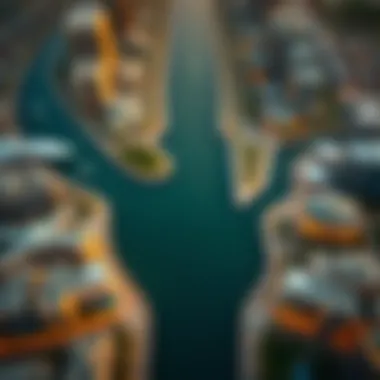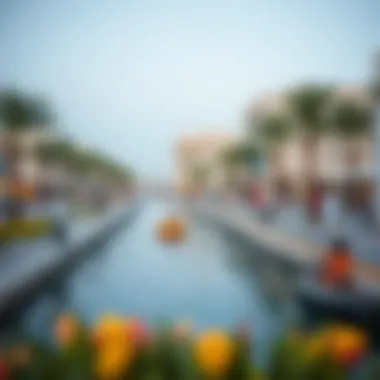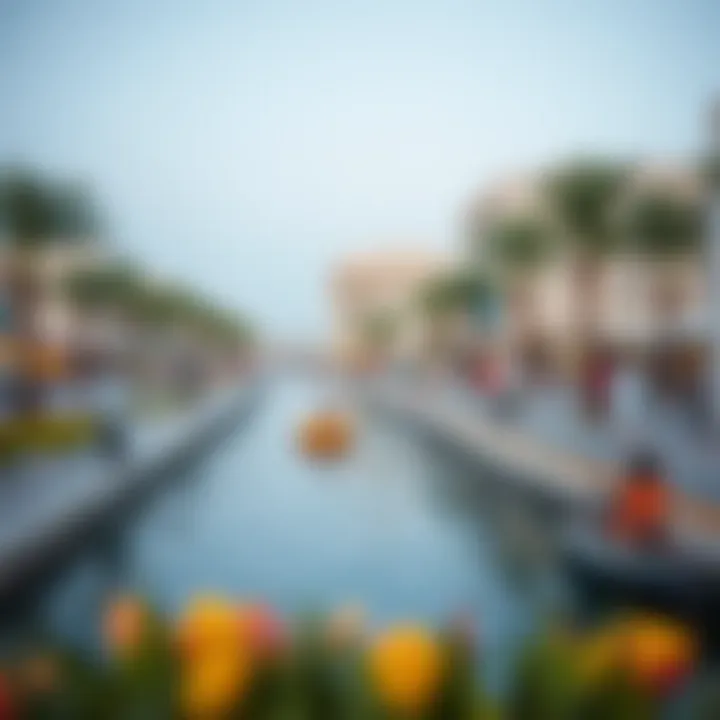The Water Canal in Abu Dhabi: A Comprehensive Analysis


Intro
The Water Canal in Abu Dhabi is not just a marvel of engineering; it’s a symbol of the city's ambition and growth. Stretching across the heart of the emirate, this waterway has reshaped the urban landscape while casting a profound influence on local communities and the economy. Understanding the true essence of this canal involves more than just exploring its waters; it means delving into its impact on real estate dynamics, environmental challenges, and the socio-economic environment that defines Abu Dhabi today.
Over the years, the canal has become a focal point for tourists and residents alike, providing recreational spaces, scenic views, and avenues for business development. In a city where skyscrapers rise to touch the clouds, the Water Canal serves as a refreshing breath of natural beauty, intertwining with urban life.
Throughout this article, we will dissect the multifaceted nature of the canal—its design elements, construction details, current usage, and community perspectives that reflect its growing importance. Join us as we explore how this waterway influences not just the physical space but the very fabric of society in Abu Dhabi.
Overview of the Water Canal
The Water Canal in Abu Dhabi serves as a remarkable engineering feat, symbolizing urban innovation and sustainable investment in the city's future. Key to understanding the overall narrative of Abu Dhabi's urban expansion, the canal provides not just a scenic backdrop but also profound socio-economic benefits. In this section, we delve into the significance of the canal, both in terms of its design and its multifaceted role within the community.
Prologue to Abu Dhabi's Water Canal
Nestled within the busy metropolis of Abu Dhabi, the Water Canal stretches gracefully, bridging different sections of this vibrant city. Completed recently, its establishment has been a turning point in the urban landscape. The canal does not merely function as an aesthetic element but is a vital component of urban infrastructure that promotes ecological sustainability.
The canal enhances accessibility by connecting major districts, allowing residents and tourists to navigate the city efficiently. This connectivity fosters social cohesion while opening doors for local businesses and tourism. As a recreational space, the canal invites activities like walking, cycling, and private watercraft use, which nurtures community engagement.
Historical Context
To appreciate the current significance of the Water Canal, one must consider the historical backdrop of Abu Dhabi. Previously, the city was marked by arid deserts and a limited urban footprint. In the late 20th century, visionary leaders initiated urban development programs aimed at transforming the city into a global hub. This vision culminated in the creation of the canal, a project that reflects Abu Dhabi's aspirations to integrate modernity with its rich cultural heritage.
Historically, waterways in the region have played crucial roles in trade and transportation. Drawing on this legacy, the Water Canal stands as a testament to the forward-thinking ideology of Abu Dhabi's planners. The project journey began in response to growing urban needs, aiming to give the city a new identity while addressing sustainable urban growth. As the canal now flows through various neighborhoods, it interlinks local stories and ongoing narratives, forming a living history that contributes to the fabric of community life.
"The Water Canal is not just about water; it's about creating spaces that resonate with the community and enhance the urban experience."
Through its history and ongoing evolution, the Water Canal in Abu Dhabi reflects a commitment to progressive urban design, enhancing not only the physical environment but also social bonds among residents.
Architectural Design and Features
The architectural design and features of Abu Dhabi's Water Canal are pivotal in transforming the urban landscape. This intricate system doesn't simply serve an aesthetic purpose; it embodies engineering feats while making profound statements regarding the city's identity and aspirations. This section delves into the foundational design principles that guided the project's creation, followed by the engineering challenges encountered during its development.
Design Principles
The design principles of the Water Canal in Abu Dhabi revolve around harmony, functionality, and sustainability. Each element is meticulously considered to create not just a beautiful sight but a functional space benefiting both residents and wildlife.
1. Integration with Surroundings:
The canal's design actively incorporates its surrounding environment, improving connectivity between different neighborhoods. Walking paths and bike trails run alongside the waterway, promoting outdoor activities and emphasizing active living.
2. Aesthetic Appeal:
The architecture of the canal reflects a modern touch that resonates with the local culture. With intricate bridges adorned with artistic features, the design adds character, creating memorable landmarks throughout the area. The attention to detail helps blend modernity with tradition, appealing to both locals and visitors.
3. Sustainable Practices:
A vital consideration in the design was sustainability. By featuring systems that promote biodiversity and improve water quality, the canal stands as a blueprint for future developments in urban settings. Native plants along the banks support local wildlife while ensuring minimal ecological disruption, showcasing a holistic approach to urban planning.
Engineering Challenges
Despite the careful planning and design, the construction of the Water Canal faced its fair share of engineering challenges. Addressing these obstacles required a combination of innovation and practical solutions.
1. Geological Constraints:
One significant hurdle during the development was the geological makeup of the region. These ground conditions posed risks during excavation and construction phases. To counter these issues, specialized tunneling and dredging techniques were deployed, ensuring the structural integrity of the canal.
2. Water Management:
Maintaining water quality in a man-made canal presents numerous challenges. The engineers needed to implement sophisticated filtration and circulation systems to keep the water clean and vibrant. Regular monitoring of the water quality ensures that aquatic life thrives along the canal, vital for both ecological balance and aesthetic beauty.
3. Infrastructure Integration:
Another complexity lay in integrating the canal with existing urban infrastructure. With roads, buildings, and public spaces nearby, coordinating construction efforts to minimize disruption was key. This intricate dance of logistics took thoughtful planning and constant communication among builders, city planners, and environmental specialists.
"The Water Canal is not just a channel for water; it's a lifeline that incorporates nature, community space, and an urban core into one seamless entity."
The architectural design and engineering challenges faced during the development of Abu Dhabi's Water Canal underscore its significance as a cornerstone of the city’s growth. Its thoughtful designs and overcoming of obstacles reflect the ambition of the region, aiming for a balance between modern development and environmental stewardship.
Environmental Impact
The Water Canal in Abu Dhabi is not just an architectural marvel; it embodies significant environmental considerations essential for its sustainable operation. Understanding its impact on the surrounding ecosystems and how it integrates into the urban environment is key for various stakeholders, including homebuyers, investors, and developers. The balance between progress and nature lays the foundation for responsible urban development, providing clear pathways for future advancements in similar infrastructures.
Ecological Considerations
The Water Canal serves as a habitat for various flora and fauna, functioning as a vital ecological corridor. As a centerpiece of Abu Dhabi's urban planning, the canal directly influences local biodiversity. The creation of this waterway has introduced new aquatic ecosystems, which can lead to the revitalization of native species.
- Biodiversity Boost: The presence of aquatic plants along the banks enhances the biodiversity of the area. These plants serve as nurseries for fish and shelter for birds, contributing positively to local wildlife.
- Natural Filtration: The canal system encourages natural water filtration processes. This can significantly improve local water quality, adapting to changing environmental factors.
- Green Spaces: Adjacent parks and recreational areas have been developed, promoting local ecological health while providing residents and visitors with green spaces for leisure.
However, the introduction of artificial waterways can come with challenges. As species interact with the new environment, there can be concerns regarding invasive species disrupting the natural balance. Each step taken in planning must consider the ecological ramifications to mitigate potential negative outcomes.
Water Quality Management
Managing the water quality of the canal is paramount. It influences not just the aquatic life but also the overall health of the adjacent land and populations. This management involves regular monitoring and treatment, ensuring a clean and sustainable water supply.
Here are key aspects of water quality management:
- Quality Monitoring Systems: Regular testing for pollutants and monitoring of nutrient levels is vital. These assessments help in making informed decisions for water treatment to ensure that the canal remains a safe and vibrant ecosystem.
- Wastewater Treatment: Initiatives to recycle water from nearby facilities provide an effective solution for maintaining water levels while minimizing environmental impact. Waste management practices also play a crucial role in preventing contaminants from entering the canal.
- Community Involvement: Local residents and organizations often partake in initiatives focused on maintaining water quality. Awareness campaigns educate the public on the importance of keeping the canal clean and reducing littering, creating a communal sense of responsibility.
"The quality of water not only dictates the health of the ecosystem but also affects the enjoyment of all who live around or visit the canal."
In summary, while the construction of the Water Canal brings numerous ecological benefits and enhancements to water quality, it necessitates ongoing vigilance. Stakeholders must work hand in hand to ensure that the environmental impacts remain positive, paving the way for further developments that harmonize urban life and nature in Abu Dhabi.


Socio-Economic Implications
The socio-economic implications of the Water Canal in Abu Dhabi extend far beyond mere aesthetics. This intricate waterway serves as a catalyst for growth, driving local development and altering the economic landscape of the region. By analyzing the effects on local businesses and real estate values, we can uncover the underlying benefits and considerations tied to this monumental project.
Impact on Local Businesses
The Water Canal is not just a pretty face gracing the city; it has invaluable impacts on local businesses. Amidst the scenic backdrop, various establishments have flourished. From quaint cafes to upscale restaurants, the influx of visitors has transformed Abu Dhabi into a vibrant hub of commerce.
For example, take a look at how the dining scene has changed. Restaurants like The Cheesecake Factory at the Marina have gained significantly from increased foot traffic. The canal attracts tourists and locals alike, giving businesses a double whammy of customers.
In addition to hospitality, retail outlets have also benefitted. Specialty shops along the canal have seen their sales rise as people explore the area. Local artisans are setting up pop-up shops that celebrate the unique cultural narratives of the UAE.
Moreover, the canal encourages collaborations between businesses, creating a conducive environment for partnerships. A local gym might collaborate with a nearby health food café, resulting in promotional offers for health-conscious customers. Therefore, the ecosystem of businesses thrives symbiotically, creating a buzz that benefits all.
"The Water Canal has reshaped our business strategies; we are no longer just selling a product but an experience."
– Local Business Owner
Enhancement of Real Estate Values
One of the most crucial socio-economic implications is the enhancement of real estate values in the vicinity of the canal. Opportunities abound for both homebuyers and investors, as properties near the waterway witness heightened demand. Historical trends show that properties located close to waterways tend to appreciate faster than others. In Abu Dhabi, this holds true as developments like the Al Marina area have seen property values skyrocket.
The canal serves as a magnet for prospective buyers looking for a lifestyle change. Luxury apartments with canal views have become highly sought after, attracting expatriates who crave an upscale lifestyle amid nature. This interest doesn't just benefit the sellers; it also boosts local economies by increasing tax revenues and spurring infrastructure investments.
Long-term projections indicate that investment opportunities around the canal will continue to flourish, as ongoing development is planned. With amenities such as waterfront parks, walking trails, and cultural centres, residents can expect not just a place to live but a community enriched by nature and culture.
In summary, the socio-economic landscape resulting from the Water Canal is dynamic and promising. From local businesses enjoying the buzz of increased foot traffic to rising real estate values, the implications are profoundly interwoven with the overall growth story of Abu Dhabi.
Community Involvement
Community involvement plays a pivotal role in shaping the identity and functionality of Abu Dhabi's Water Canal. It creates a sense of belonging and fosters a collaborative environment where local residents and stakeholders can work hand in hand. When a community actively engages with a project like the canal, it not only promotes inclusivity but also enriches the cultural fabric of the area. The benefits of community involvement are multifaceted, encompassing social, economic, and environmental aspects that culminate in a vibrant urban setting.
Public Perception
The public perception of the Water Canal is crucial for its long-term success and sustainability. As the canal serves as a hub for leisure, tourism, and transportation, the way local residents feel about it can significantly impact its usage and popularity. Many residents view the canal as a positive addition to the cityscape, appreciating the enhanced aesthetic of the waterfront and the recreational opportunities it presents.
Moreover, public sentiment can be shaped by factors such as community outreach, transparency in planning, and opportunities for feedback during the development process. As stakeholders engage with residents through surveys, forums, or social media platforms, their thoughts and suggestions can lead to improvements that benefit all. For example, residents have expressed desire for more green spaces along the canal, promoting an environment where families can gather, which in turn can increase foot traffic in local businesses nearby.
"Public engagement transforms projects from mere infrastructure to community milestones, forging bonds and instilling pride."
Local Events and Festivals
Local events and festivals centered around the Water Canal not only showcase the canal itself but also serve to strengthen community bonds. Events range from cultural festivals celebrating Abu Dhabi's rich heritage to recreational activities like water sports competitions and art fairs. For instance, the annual Waterfront Festival attracts visitors and residents alike, bringing together local food vendors, artists, and performers. Such gatherings elevate the canal's profile as a community space where people can congregate and share experiences.
These events also provide vital economic stimulation for local businesses. When festivals draw crowds, nearby shops, restaurants, and cafes benefit from increased patronage. This synergy fosters a sense of community pride and ownership over the canal, encouraging residents to advocate for its preservation and continued development. Additionally, organizing events can help spotlight local talent, giving creatives a platform to showcase their work to a wider audience, thus enriching the local cultural scene.
Tourism Potential
The Water Canal in Abu Dhabi serves as more than just a waterway; it has become a linchpin for tourism within the city. As global tourism continues to evolve, destinations that offer unique experiences are increasingly favored by travelers. The canal contributes through various attractions, activities, and the enhancement of the urban landscape, making it a key point of interest for tourists and local residents alike.
Attractions Along the Canal
The canal is lined with numerous attractions designed to appeal to a variety of audiences, from families seeking leisure activities to photographers hunting for picturesque scenes. Some notable attractions include:
- Stunning Walkways: The pedestrian paths alongside the canal offer breathtaking views of the water and city. These walkways are perfect for casual strolls or more vigorous jogs, attracting fitness enthusiasts and families.
- Art Installations: The canal features various art installations and sculptures that add a cultural dimension to the experience. They provide delightful stops for photographs and inspire reflections on local heritage.
- Restaurants and Cafés: A variety of eating establishments line the waterway, each offering distinctive culinary experiences. Patrons can enjoy local Emirati cuisine or international fare while overlooking the water, creating a relaxed ambiance that enhances dining.
- Boat Tours: For those looking to experience the canal from a different perspective, boat tours are readily available. These provide an opportunity to explore uncharted sights and gain knowledge about the history and environmental significance of the area.
- Public Parks: Open green spaces along the canal offer a haven for families, bringing together community-oriented events, picnics, and children's activities. It is a gathering place that fosters community spirit while emphasizing outdoor recreation.
With these attractions, the canal encourages visitors to spend more time in the city, cultivating a strong connection between the waterway and tourism growth.
Tourist Engagement Strategies
To further leverage the potential of the Water Canal, strategic engagement initiatives are crucial. Effective tourism strategies can enhance visitor experience and reception, leading to increased foot traffic and greater overall satisfaction. Some of the key strategies include:
- Cultural Events: Hosting events such as traditional music festivals or art exhibitions along the canal can draw in tourists. By celebrating local culture, the area showcases its unique identity while creating memorable experiences.
- Guided Tours: Providing knowledgeable guides will enrich visitors' understanding of the canal's history and functionality. By incorporating storytelling techniques, tours can transform a simple visit into an immersive learning experience.
- Sustainability Initiatives: As more travelers become conscious of their environmental footprints, integrating sustainability practices in tourism can attract eco-conscious visitors. Initiatives such as promoting the use of bicycles or electric boats contribute positively to the canal's appeal.
- Digital Marketing: Utilizing social media platforms to promote visual content of the canal's beauty can be invaluable. Eye-catching posts can entice potential visitors, leading to an organic increase in tourist engagement.
- Collaborations with Local Businesses: Working with nearby businesses, hotels, and attractions can create a more comprehensive travel package for tourists. This strategy not only promotes the canal but also enhances the overall tourist experience.
Developing these engagement strategies will help position the Water Canal as a dynamic destination, ensuring its place in Abu Dhabi’s thriving tourism sector.
The potential for tourism along the Water Canal is immense, providing opportunities for economic growth while enhancing the cultural fabric of Abu Dhabi.
Future Developments
The future of the Water Canal in Abu Dhabi is nothing short of promising. As the city continues to evolve, it recognizes the importance of this waterway as a pivotal aspect of urban development. Future developments regarding the canal will not only enhance its physical attributes but also its role in community integration and environmental sustainability.
Why Future Developments Matter:
These developments are crucial for various reasons:
- Urban Growth: As Abu Dhabi seeks to accommodate an increasing population, the canal will serve as a vital artery, facilitating transportation and connectivity.
- Economic Opportunities: Expanded developments around the canal will likely attract new businesses and tourism, stimulating further investments.
- Sustainability Focus: Future enhancements will also prioritize ecological balance, fostering a green approach, ensuring the canal's water remains clean and its surroundings vibrant.
Planned Expansions
One of the most exciting prospects for the Water Canal involves the planned expansions expected over the next several years. Local authorities have laid out ambitious plans that aim to broaden the scope and usage of the canal.
- Extending the Waterway: Plans include extending the canal into neighboring districts, which will not just enhance physical connections but also open up new areas for recreational activities and waterfront development.
- Quayside Developments: Local businesses can look forward to quayside expansion, creating a vibrant atmosphere filled with restaurants, cafes, and retail options.
- Public Spaces: The hope is that future phases will include more public spaces, parks, and pedestrian paths that embrace the canal, fostering community interaction and engagement.
As these expansions roll out, residents are expected to enjoy more opportunities for leisure and relaxation, reinforcing the canal's role as a community hub.


Long-term Vision for the Canal
The long-term vision for the Water Canal in Abu Dhabi encapsulates a holistic approach to urban design and community embedding. Stakeholders are looking towards achieving a balanced integration between the waterway and the urban environment that surrounds it.
- Cultural Integration: Future plans envision the canal as a cultural centerpiece, with initiatives to host art installations, events, and performances that draw local and international crowds.
- Environmental Resilience: The vision emphasizes ecological health, with plans to incorporate rainwater harvesting systems and employ filtration technologies to maintain water quality naturally.
- Innovative Transport Solutions: A long-term goal includes innovative transport solutions, linking the canal with public transit systems to ease congestion and improve accessibility.
Overall, the emphasis on these long-term aspirations underpins a commitment to creating not just a scenic canal but a thriving dynamic that reflects Abu Dhabi's ambition as a major urban center in the Middle East.
"In the eyes of the planners, the Water Canal is not merely a channel for water, but a conduit for future possibilities."
This foresight ensures that the Water Canal not only serves the present but also stands as a foundational element of Abu Dhabi's future.
Integration with Urban Landscape
The integration of the Water Canal in Abu Dhabi within the urban landscape is not just a frosting on the cake; it’s a fundamental ingredient that enriches the city's socio-economic and environmental contours. As communities evolve in response to changes, the canal serves as a vital artery that fosters connectivity and enhances the quality of life.
Connecting Neighborhoods
One of the notable aspects of integration is how the Water Canal serves as a nexus among diverse neighborhoods. It stitches together a quilt of urban spaces, seamlessly linking residential areas, commercial hubs, and recreational zones. The canal's promenades, adorned with lush landscaping, offer residents a retreat from the urban rush while promoting social interaction.
There’s an allure to walking along its banks, where families and friends gather for leisurely strolls or joggers hit their daily strides. This connectivity not only encourages physical activity but also fosters a sense of community. In many ways, the canal becomes a shared asset, descending beyond mere infrastructure; it embodies the spirit of unity among residents.
Key Elements of Neighborhood Connection:
- Enhanced Accessibility: Pathways connect various neighborhoods, reducing travel time and increasing walking traffic.
- Public Spaces: Parks and recreational areas along the canal surface new opportunities for community engagement.
- Cultural Interaction: The canal supports local artists and promotes events, reinforcing community ties.
Transportation Links
Linking neighborhoods isn’t solely about walkability; it extends deep into the transportation network. The Water Canal incorporates and facilitates efficient transportation options, bridging gaps between critical areas of the city. Newly constructed cycle paths and pedestrian walkways alongside the canal invite alternative transportation modes that lessen the reliance on vehicles.
Moreover, the integration of water taxis and public transport options bolsters mobility, making it easier for people to traverse from one area to the next without hassle. It’s a vision of transport that aligns with sustainability while enhancing the overall urban experience.
Insights on Transportation Links:
- Water Taxis: They provide unique travel options for commuters and tourists alike.
- Cycle Paths: Dedicated lanes encourage biking, cutting down on carbon emissions.
- Public Transit Accessibility: The nearby metro and bus services complement the canal's design, creating a reliable transport network.
"A well-integrated transportation system can elevate urban life, offering convenience while simultaneously addressing environmental concerns."
As the Water Canal thrives, it increasingly resonates with Abu Dhabi's broader ambitions—transforming the city into a beacon of modern living while keeping step with its rich heritage. By marrying the natural and urban environments through strategic planning and thoughtful design, the canal represents an exemplary model of urban integration.
Cultural Significance
The cultural significance of the Water Canal in Abu Dhabi stretches far beyond its practical utility. This remarkable waterway serves as a bridge—not just between different parts of the city—but also between the past and present, tradition and modernity. It embodies the spirit of Abu Dhabi, melding history with innovation while enhancing the social fabric of the city.
Art and Design Inspirations
When it comes to art and design, the Water Canal is a canvas painted with both natural beauty and human creativity. Architects and designers drew inspiration from various sources, including the natural landscape of the region and traditional Emirati motifs. The canal’s design incorporates gentle curves and flowing lines, reminiscent of the winding paths of the desert, mimicking the organic flow of the water. Artists have also infused local elements into bridges and public spaces that line the canal.
- Local artisans have contributed handmade tiles and mosaic designs that reflect the culture of Abu Dhabi,
- Public art installations along the canal engage citizens and visitors alike, inviting them to appreciate local heritage.
These artistic expressions create a harmonious blend of aesthetics and functionality, explaining why the canal is more than just a transportation route. It stands as a testament to the city’s commitment to preserving cultural identity while fostering modern urban living.
"Public art and urban design can work hand in hand, creating spaces that resonate with people and reflect their shared histories."
Historical Narratives
The historical narratives tied to this waterway are rich and varied. They are woven into the very essence of Abu Dhabi's development. The Water Canal draws from the country's ancient reliance on waterways for trade and sustenance. Long before this modern canal came to life, the coastal and inland waters played crucial roles in the lives of Emiratis. They were essential for fishing, trade with neighboring regions, and even agriculture.
The Water Canal can be seen as a revitalization of these age-old practices, bringing the community back in touch with its roots while also paving the way for future sustainability.
- It commemorates the local fishermen and traders who once relied on these waters for their livelihood.
- The canal embodies Abu Dhabi’s transition from a pearl-diving economy to a thriving modern metropolis, symbolizing growth and transformation.
Such narratives go beyond mere stories; they enrich the identity of the canal, making it a point of pride for both locals and visitors. Understanding this history is key for homebuyers and investors, as it highlights the cultural layers embedded in the urban landscape. To digest the significance of the Water Canal is to grasp a piece of Abu Dhabi’s essence.
For more information on Abu Dhabi's cultural history, you can visit Wikipedia and Britannica for a comprehensive overview.
Safety and Accessibility
The Water Canal in Abu Dhabi stands as a pivotal structure in the region's urban development. However, beyond its aesthetic and economic contributions, it is vital to emphasize the elements of safety and accessibility associated with it. Ensuring that this area is safe for all visitors and residents is paramount. Likewise, guaranteeing access for all demographics fosters inclusivity, enhances community engagement, and boosts economic activities.
Safety Measures in Place
Safety measures around the Water Canal are rigorously implemented to protect both visitors and the environment. One of the chief priorities involves regular maintenance and inspections of the infrastructure, ensuring that pathways, bridges, and parks are in top condition.
- Surveillance Systems: The authority has invested in modern surveillance systems throughout the canal, enhancing real-time monitoring to quickly respond to any emergencies.
- Lighting: Adequate and strategic lighting along walkways and public areas improves visibility, deterring crime and enhancing user experience during evening hours.
- Emergency Services: Visibility of emergency services is a key component. Designated zones along the canal are equipped with first aid kits and staffed by trained personnel ready to assist in case of incidents.
"Safety first is safety always." This adage holds especially true in urban planning, where proactive measures can significantly reduce risks for all involved.
Accessibility for All


Accessibility is more than just a buzzword; it’s about creating a welcoming space for everyone. The Water Canal has taken significant strides in this realm.
- Universal Design: Pathways adhere to universal design principles ensuring wheelchair accessibility and mobility assistance, accommodating individuals with varying needs.
- Public Transport Links: Well-placed public transport links facilitate easy access to the canal, encouraging more visitors to experience this stunning terrain. The proximity of bus stops and the metro to the canal sets a convenient foundation for great connectivity.
- Visitor Amenities: Utilizing tactile paving for the visually impaired makes navigating the surrounding areas easier and safer. Benches and rest areas are plentiful, providing necessary respite for all.
Case Studies
In understanding the Water Canal in Abu Dhabi, it’s essential to examine case studies that provide insights into similar projects worldwide. Case studies reveal the common threads of success and challenges in canal development, particularly in urban settings. Analyzing specific instances can illuminate why certain designs work, what engineering obstacles arose, and how communities reacted. Moreover, engaging with these narratives encourages the sharing of best practices, ultimately enhancing local initiatives. There’s a world of knowledge out there, just waiting to be explored.
Comparative Analysis with Other Canals
The exploration of canals like those in Venice or Amsterdam juxtaposes a rich history against modern innovation. For example, Venice’s intricate waterways are synonymous with both beauty and functionality. The city has anchored its tourism and real estate around the canals. In contrast, Abu Dhabi's Water Canal manifests a different narrative, focusing on modern urban living. While Venice relies on historical context, the Abu Dhabi project is more about blending the past with the future.
A few key points of comparison include:
- Design Philosophy: Venice is organic, shaped by centuries of use, while Abu Dhabi’s design intentions revolve around smart urban integration.
- Environmental Management: The water quality in Amsterdam's canals has prompted innovative solutions. Abu Dhabi aims for sustainable practices, hoping to create a balance between nature and city life.
- Socio-Economic Ties: Canals in both cities drive tourism. However, Abu Dhabi is more focused on enhancing local economy through real estate values linked to its waterway.
This comparative lens helps in understanding how different contexts influence the functionality and perception of canals, encouraging better decision-making for similar projects in emerging urban landscapes.
Lessons Learned from Global Projects
Looking at canals globally, the lessons are numerous and vital for Abu Dhabi's initiative. Projects like the Los Angeles River’s revitalization emphasize the importance of community involvement. Involving locals can cultivate a sense of ownership, essential for long-term success. Furthermore, mistakes made in cities like Tokyo, where water channels became merely utilitarian, teach us that beauty and function must coexist.
Key lessons include:
- Community Engagement: Projects thrive when communities are part of the planning and executing phases.
- Sustainability Practices: Learning from cities like Singapore, where water management is sophisticated, Abu Dhabi can implement strategies for maintaining clean water.
- Future-Proofing Developments: Cities that plan for future needs, such as climate change impacts and urban sprawl, are far better positioned than those that don't.
By synthesizing these global experiences, Abu Dhabi's Water Canal project can leverage insights to reduce risks, enhance community benefits, and ensure its role as a vital artery within the urban sprawl.
Understanding and applying lessons from past and ongoing projects is not just a matter of learning; it’s about ensuring a flourishing environment for future generations.
Regulatory Framework
Understanding the regulatory framework surrounding the Water Canal in Abu Dhabi is essential for grasping the entire scope of its development and sustainability. This framework not only lays the groundwork for construction and operational standards but also ensures that various stakeholders consider environmental and socio-economic impacts diligently. The landscape of Abu Dhabi is ever-evolving, and as such, the regulations in place are designed to adapt to new findings and challenges that arise through ongoing projects.
Government Policies
Government policies play a pivotal role in fostering the development of the Water Canal. These policies are structured to balance developmental needs with environmental prerequisites. For instance, the Water Canal aligns with the broader goals of the Abu Dhabi Vision 2030, which emphasizes sustainable development and diversifies the economy. By setting strict compliance protocols, the government ensures that the construction and maintenance of the canal contribute positively to the environment.
Some notable aspects of the current government policies include:
- Sustainability Objectives: Policies that encourage the use of green materials and technologies in construction.
- Community Engagement: Frameworks to ensure community input is considered in project planning and execution, thus fostering a sense of ownership among residents.
- Pollution Control: Regulations for monitoring and managing the quality of water in the canal to prevent any potential hazards to both the environment and public health.
These actionable policies ensure that the project not only enriches the urban fabric but is also socially responsible and environmentally sound.
Legal Considerations for Development
Legal aspects surrounding the development of the Water Canal are equally complex and significant. Various laws govern land use, construction permits, and environmental conservation, reflecting Abu Dhabi’s commitment to lawful and equitable progress.
Key legal considerations include:
- Zoning Laws: Established to regulate land usage, ensuring that the canal integrates smoothly into existing communities without compromising residential living or commercial activities.
- Environmental Laws: Strict adherence to regulations designed to protect natural resources. Developers must conduct environmental impact assessments (EIAs) to evaluate potential consequences before commencing construction.
- Public Access Regulations: Legal frameworks that mandate the canal remain accessible for community use, ensuring that it is not just a private or tourist space but a public asset for recreation and leisure.
In summary, the regulatory framework, encompassing both governmental policies and legal considerations, is instrumental in shaping the future of the Water Canal. It not only mitigates risks but also optimizes opportunities for sustainable urban growth, guiding both investors and developers toward making informed decisions that benefit the entire community.
"A well-structured regulatory framework is the backbone of any successful urban project. It fosters trust and sustainability."
By weaving together these guidelines, Abu Dhabi aims to create a canal that is not just an aesthetic landmark but also a functional space that supports varied community activities and environmental harmony.
Finale
The importance of this conclusion cannot be overstated, as it synthesizes the intricate threads woven throughout the discussion surrounding the Water Canal in Abu Dhabi. Considering the social, environmental, and economic dimensions, a deep dive into this man-made marvel reveals how its creation has reshaped urban dynamics in the emirate.
First off, from a socio-economic standpoint, the canal has catalyzed growth—boosting local businesses and raising property values. It has transformed previously underutilized areas into thriving hubs, enticing investors and homebuyers alike. Furthermore, the canal has fostered community interactions and events, adding a lively touch to Abu Dhabi's cultural fabric.
In terms of environmental significance, the canal plays a pivotal role in urban ecology. By improving water management and providing a habitat for various species, it has enhanced Abu Dhabi's sustainability efforts. This is particularly crucial in a desert environment where water resource management is a constant challenge.
Finally, consideration of the future opportunities tied to the Water Canal demonstrates its continuing evolution. As plans for expansions and community enhancements are set into motion, the canal will likely remain a central feature of Abu Dhabi's urban landscape. The ongoing dialogue about its impact ensures that stakeholders from real estate developers to local residents remain engaged and informed.
"Sustaining the waterway involves a collective effort from all segments of society, emphasizing the vital role of community action in maintaining urban vitality."
In essence, this reflective examination serves as both a summary and a motivational push for stakeholders to acknowledge and embrace the multifaceted benefits the Water Canal brings.
Summary of Findings
The findings point to a striking correlation between the canal's introduction and notable advancements within Abu Dhabi. Among the key takeaways are:
- Economic Growth: Rampant demand for homes and commercial spaces around the canal has surged.
- Community Engagement: Public events and festivals promote inclusivity and pride among local residents.
- Environmental Management: The canal contributes to ecological balance, supporting biodiversity and combatting urban heat.
These facets collectively highlight how the Water Canal serves as more than a mere waterway but as an essential artery of urban life transforming Abu Dhabi into a modern metropolis.
Future Opportunities
Looking ahead, the potential for further developments alongside the canal is immense. Here are some key areas ripe for exploration:
- Urban Integration: Future projects can focus on integrating the canal more seamlessly with public transport networks, enhancing accessibility.
- Sustainability Initiatives: New environmental programs can be launched to preserve water quality and promote biodiversity along the canal.
- Real Estate Innovations: Developers are poised to capitalize on growing demand for luxurious waterfront living, with eco-minded projects ensuring long-term viability.
As each of these opportunities unfolds, the Water Canal will undeniably remain at the forefront of Abu Dhabi's urban narrative, beckoning future generations to engage with its waters and the unique experiences it offers.



